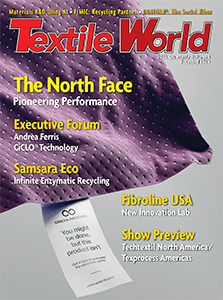In anticipation of the forthcoming ITMA in Barcelona, Spain, the Rupp Report is taking a closer
look at some exhibitors that will take part in the exhibition in Catalonia’s capital city. Here is
the first story:
At ITMA 1999 in Paris, there was an exhibit in the booth of Germany-based Grosse Jac
Webereimaschinen GmbH that had never before been seen: a UniShed Jacquard machine that did not have
a harness. It was one of the very few sensations in Paris. After that, not much followed. Now the
company has come back to the surface under a new name. The Rupp Report interviewed Dr. Roberta
Boscoli, sales director of GITEC Grosse Internationale Technologie GmbH, about the future of the
company.
Grosse was founded 1878 in Greiz, in the eastern part of Germany. Over time, the company
became one of the leading producers of mechanical Jacquard machines, offered under the Unirapid
name. And, as mentioned above, the company introduced the UniShed harnessless Jacquard machine in
1999. However, after that event in Paris, the company somewhat disappeared from the markets.
Quite unnoticed by the public, Grosse was taken over in 2005 by China-based Hisun Group Co.
Ltd., which consequently led to the establishment of GITEC Grosse Internationale Technologie GmbH
in Ulm-Lehr in southern Germany, as a daughter company of the Hisun Group.
Same Expertise
Today, GITEC Grosse is in the same business as before: the company produces electronic
Jacquard machines in sizes ranging from 1,344 up to 12,000 hooks. Potential users are the
traditional weaving mills producing a broad range of products, including home textiles, as well as
producers of industrial fabrics. Ninety-five percent of all products are exported – at the moment,
mainly to China, India and Turkey. Furthermore, its product line includes the latest generation of
harnessless Jacquard machines, the UniShed 2 for the production of airbag fabrics. This optimized
model will be shown in Barcelona.
Boscoli said the company is working with a kind of cluster network in the global textile
regions, such as China, India and other regions. In the clusters, field representatives are in
constant contact with the customers, but also GITEC Grosse staff in the respective countries are
taking care of the customers, supported by the field personnel.
Markets
Boscoli mentioned that the current market is recovering after a time of recession. The
company is enjoying an increasing number of inquiries from Europe and North America for technical
fabrics applications.
However, the current bestseller in the program is the electronic Jacquard machine EJT-4,
which is especially suitable for terry fabrics. Thanks to some particular feature,s the machine
produces an even pile surface, which is claimed to deliver a very good terry fabric quality.
For standard products, there is a great deal of competition among producers, Boscoli said,
mainly with cheap products from China. In the high-level segments, she claims there are no
problems, thanks to GITEC Grosse’s unique products.
ITMA Barcelona
As GITEC Grosse is also an original equipment manufacturer, there will be a few products
seen in the booth of its China-based sister company Zhejiang Grosse Precision Machinery Co. Ltd.;
in Japan-based Tsudakoma Corp.’s booth, which will be showing a UniShed 2; and in the booth of
Italy-based Smit Textile S.p.A., which will display an EJP-4 on a rapier weaving machine.
The expectations of the new old company are high: to consolidate its market presence,
winning new customers, but also to confirm some trends relating to the new UniShed 2 for airbags.
The Future
Regarding developments in the near future, the clear vision is to gain more application
areas for the UniShed 2; mainly for industrial fabrics and top-level products. This goes in line
with the targets for the next few years: further increase in market share; market implementation of
the UniShed; and, on top of all, Boscoli said, re-establishment of the Grosse brand.
And how does Boscoli see the future? “I am certain that the Indian market will experience an
upgrade of the machinery technology for standard products. Europe and North America will slightly
assert their market lead in the segment of technical textiles – but these regions have to be aware
of China: That country will soon become an important player in this segment,” she said.
August 16, 2011




